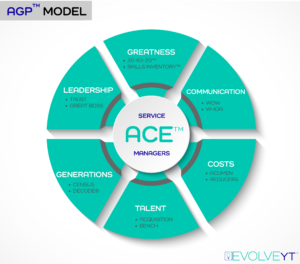Request More Information about the Accelerated Gross Profit (AGP)™ Book

The Accelerated Gross Profit (AGP) Program is changing the way field service companies approach talent development. The new book from Phil Cooper illustrates his unique process for developing field service supervisors by using intentional activities, consistent cadence and exceptional execution.
Check out an excerpt from the book below as well as our form to be notified of pre-orders!
Be the FIRST to Know!
Interested in the AGP Book?
Use the form below to get notified about pre-orders of the Accelerated Gross Profit book.
Anticipated release fall 2023.
Excerpt from the Accelerated Gross Profit Book
Chapter 1
Did you know one of the biggest impacts on your company’s profit could be sitting at your manager’s desk?
Middle management is the number one under-resourced position with the greatest impact on gross profit. In fact, the very backbone of your field service company is your service managers. So why are they the most underserved position in the industry?
This book is about achieving accelerated gross profit, and the path to getting there is simple. It involves enabling your field service managers – your middle management, your supervisors – to be great. 
The role of a field service manager
The role of a field service manager is terribly misunderstood. Ask yourself, what is your field service manager truly responsible for? The most common answer is “client satisfaction.” The second most common answer is being available for their technicians. But take a step back. The ultimate objective is simple: to make their team great.
Think about it, if your supervisors’ teams are crushing it in their day to day, you can expect great customer service. Ultimately, in a field service company, the better the technicians are, the better the gross profit becomes.
Sadly, the opposite is also true.
My company started out as Cooper Pest, a family company I’ve come a long way with and have evolved into the successful training organization we are today, Evolve YT. But I didn’t always know what I know today. I once had an ineffective manager I kept on for over ten years, simply because I didn’t have the manpower to replace him. I knew he wasn’t the best at his role, but he was still a good person, so I tried to overlook his flaws.
That was a huge, costly mistake.
Over the course of the ten years, he damaged his team’s morale so badly it resulted in over twenty technicians quitting. With every technician resignation, Cooper Pest lost over $15,000. It was a costly mistake that I vowed to never repeat, which is why I developed our internal leadership program, so I could avoid ever putting the wrong person in the wrong seat again.
This wasn’t my only challenge, but it was one of a series that led to me understanding that I needed to focus on my company’s lifeline – my service managers. My team needed to come first.
As an owner, you may not even realize that your middle management is the lifeblood of your company, but trust me, they are. These are the people doing double duty by reporting to the leadership teams while also cascading down visions and culture to your front-line technicians, supporting and guiding them to do their job.
We ask our service managers to do so many things, so why don’t we train them?
Where’s my training? 
According to a 2018 LinkedIn Workspace Learning Report, ninety-four per cent of employees would stay at a company longer if it invested in their career.
But unlike their technicians, who are receiving ongoing training and certifications for their position, and the C-suite executives who obtain leadership training throughout their careers, when a supervisor steps into their position, they are left grasping for any type of training they can grab ahold of that will help them in their new role.
This is the crux of the problem, but it begins with where we actually get our service mangers from.
Almost universally, whether we are an HVAC, landscaping, lawn, pool, elevator or pest control company, all of us field service companies have supervisors for our field personal, our technicians. And where do the supervisors come from? The technician base. When it comes time to fill a supervisor position, we look within our companies, find the technician who we think is going to be the best fit, perhaps do an interview and award this person the position. Some of the more progressive companies will enroll the new supervisor in some online courses and offer them some leadership books, and the best may have some actual leadership classes to help the new supervisor on their way.
But when we really examine this, rarely does this technician who is now a supervisor really know the stuff they need to do. And there is so much to learn. Do they know how to educate and teach? Do they possess all the soft skills necessary to produce great customer service? Do they know how to manage their time so they can be effective with their entire team? This is just the beginning of the list of questions that truly do not get answered the way they should.
As Simon Sinek points out, “Middle management is the hardest job in any organization because when you’re junior, your only job is to really just do your job. And you get trained on how to do your job. If you’re really good at it, you eventually get promoted to manage the people who do the job you used to do. But the problem is, they don’t give us any training on how to do that.”
In many companies, it does not stop there. We saddle these new managers with production (actual client jobs) and other duties, as well as asking them to manage their field staff. What a recipe for disaster. Worse yet, we do not give them enough time to put their technicians in a winning position.
When it came to an open manager position, Cooper Pest did exactly what most companies do; we promoted the “high performer.” Now, don’t get me wrong, sometimes this formula works out like a fairy tale, but most of the time, it’s our worst nightmare.
With a lack of middle management training, companies do what they can to pick the “right” person for the position by assuming the high performer is the most logical candidate for the promotion. Unfortunately, this isn’t always the case, and many of us have learned that the hard way.
By putting your high performer into a management role blindly, you’re just asking for disaster. If the person isn’t ready for or passionate about the role, they can harm your business, starting with their team.
The answer is in vetting your potential leaders – and training them.
Learning to positively influence the behaviors of your supervisors is the key to developing and growing your middle management into the leaders your business needs. And the positive ripple effect will continue in their team as well as throughout your organization.
You might think if it was that simple everyone would be doing it. But as you navigate this book, you’ll realize it takes specific skills for supervisors to make their technicians great. The Fundamental Truth is that we have to be intentional about how a service manager constructs their day and develops the skills they need to transfer to their technicians.
And even before all this, they need two ingredients.
They need a shift in mindset
Time after time, we see service managers who are not intentional about making their team great. Of course, they want to make them better, but it is not structured with specific activities on a specific schedule with a specific outcome in mind requiring a certain level of execution. Service managers need to learn the activities that drive greatness. They then need to get those activities onto a specific cadence, or frequency, then produce replicable results team member to team member. Getting service managers to change their mindset to thinking constantly about how they are going to make their team better is where it begins.
They need to love their people 
With wanting to make your team great comes a non-negotiable item. Our service managers must genuinely care about their people, even LOVE their people. This does not mean they are their best buddy; they are still their boss. But if they do not genuinely want to make their people better, then 1) they should not be managing others, and 2) this book does not apply to them. If they truly do care and are working for an organization that supports the growth of their people, then every aspect of the training in this book is relevant.
The rest is simple. Build the right activities around individuals using a variety of tools to ensure that you are doing the correct activities to truly connect to your team, showing the care to help each person achieve their unique greatness. This is the heart of the AGP system.
The AGP system 
What if we could reshape everything to make managers strong in fundamental areas yielding accelerated gross profit (AGP)? It’s possible, and we’ve figured out how to do it. The result is the AGP system. And this book shows you how to implement it.
The AGP system is truly simple and extremely effective. We have borrowed from so many thought leaders, including Gino Wickman, EOS Worldwide, Jim Collins, Patrick Lencione, Dan Sullivan, Vinay Raman, John Maxwell and Keith Ferrazzi. Piecing the puzzle together has been a labor of love and the result is a process that can be replicated from field service company to field service company. It all boils down to six fundamentals.
Interested in the AGP Book?
Use the form below to get notified about pre-orders of the Accelerated Gross Profit book.
Anticipated release fall 2023.